This post may contain affiliate links. Please read our disclosure policy. As an Amazon Associate, I earn from qualifying purchases.
Do you want to know how to make perfect hard-boiled eggs? I’m talking easy-peel hard boil eggs. So easy that the peel just slides right off, partly intact. We have 6 different ways to make hard boiled eggs and one really important tip for perfect hard-boiled eggs every time. Can you guess all 6 ways we made hard boiled eggs? Do you know the special tip for easy-peel hard boiled eggs?
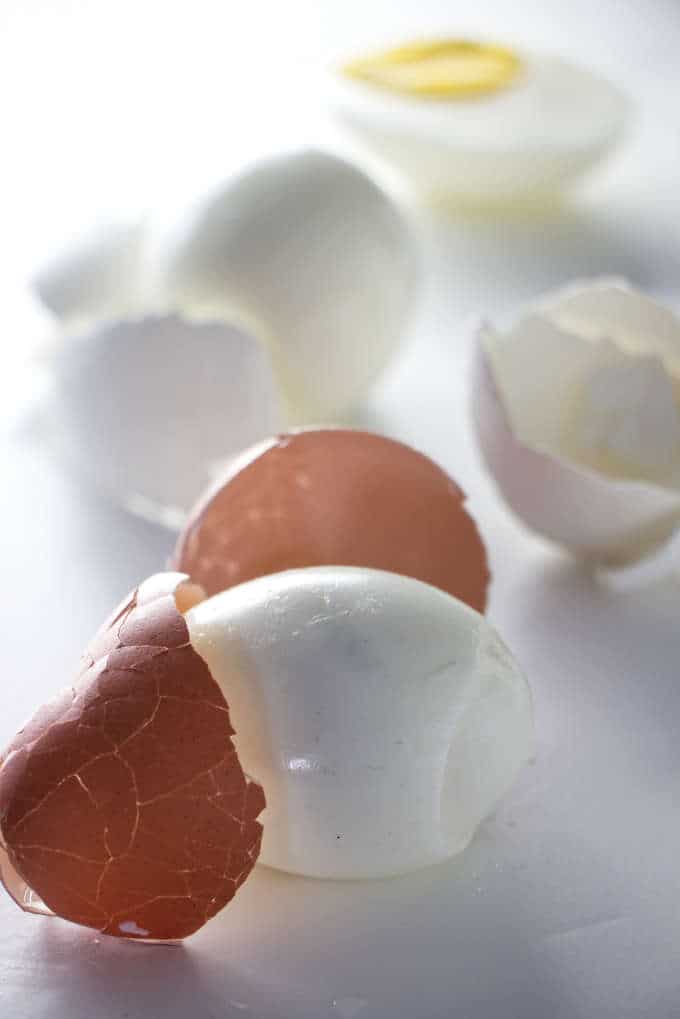
Hard boiled eggs are a classic topping for hearty salads, like my Cobb Salad or my shrimp Louie.
You guys this is a long post with a lot of photos. I am giving you instructions for 6 different methods to make hard boiled eggs that will be easy to peel. Each method has a printable recipe card so scan down until you find the method you want to try. Don’t forget to read our tips for how long to boil an egg, how to peel hard-boiled eggs, and how to prevent that ugly green ring around the egg yolk.
We went through SO MANY eggs to get this post finished. I should thank the chicken that gave us these eggs but I think I had her for dinner.
The methods we used to make hard-boiled eggs.
In case you’re wondering which 6 methods we used to make perfect hard-boiled eggs, I’m going to get the guesswork out of the way. Here are the methods we used.
- Traditional stove-top boiled eggs
- Hard-boiled eggs steamed
- Hard-boiled eggs Instant Pot style
- Egg cooker hard boiled eggs
- Hard-boiled eggs in the oven
- Hard-boiled eggs sous vide style
Now, I realize that technically, not all these methods actually use boiling water to cook the eggs. The first method is the only one that can truly be called a boiled egg. However, all of these methods produce perfect looking “hard-boiled” eggs. The kind of hard-boiled eggs that you can use for deviled eggs, or in an egg salad or even to color them for an Easter egg hunt.
When cooked correctly, these eggs will peel easily and taste like a hard-boiled egg should taste. By that, I mean they will not have a dry “chalky” yolk or tough rubbery white. These are tender eggs, with smooth, beautiful yellow yolks. And if you want soft or medium cooked eggs, we have instructions for how long to boil an egg, depending on your desired ‘doneness’, in each recipe card.
There is one exception to the “easy peel hard boiled eggs“, however. We have found that hard-boiled eggs in the oven tend to get a spot on the bottom that bakes the shell on pretty hard. The “baked-on” spot will be harder to peel and will leave a brown spot on the egg white. I will talk more about that in the recipe card for “hard-boiled eggs in the oven“.
Check out our video above to see all the methods we used to make perfect hard-boiled eggs that peel easy.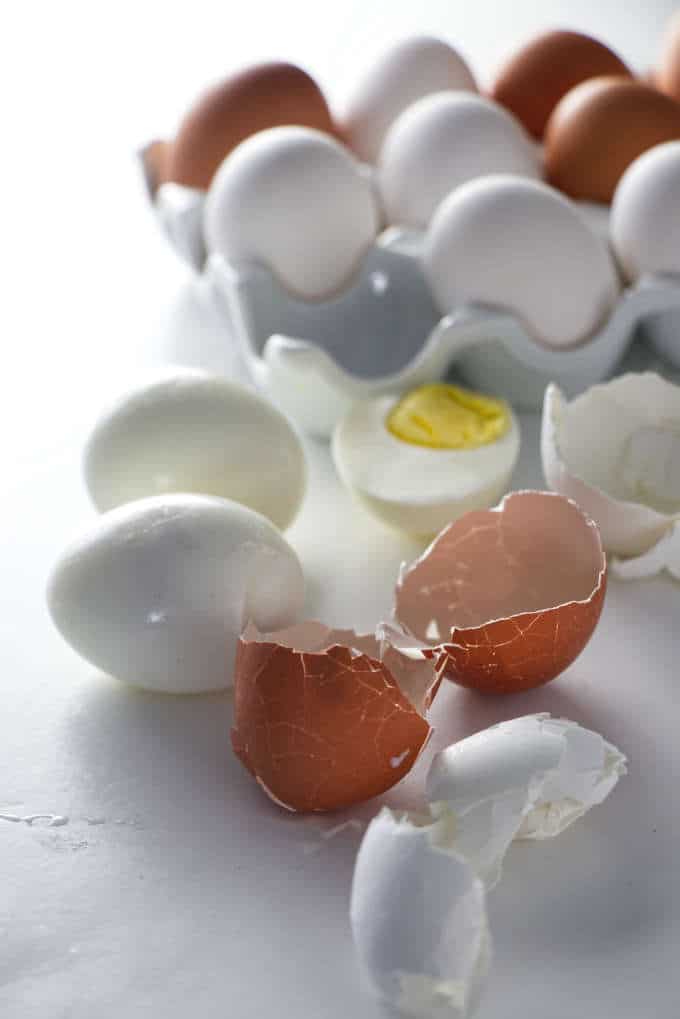
How to make easy-peel hard boiled eggs.
Here’s the deal. You gotta get the eggs hot quickly. Whether your using water, steam, or radiant heat, the eggshells will not stick to the whites of the egg if you heat them fast. Now I know there are tips and tricks that recommend adding baking soda or vinegar to the water. If you have ever tried that, you know that those tips are not fool-proof.
You need to start them in HOT water, use steam, or put them in a HOT oven. If you start the eggs in cold water THEN bring the water to a boil, you will have a lot of eggs that will be difficult to peel. Heating the egg rapidly allows the egg white that is closest to the eggshell to shrink away from the membrane quickly.
This works the same for eggs that come straight from the fridge or eggs that sat on the counter for a while.
Won’t the eggshells crack if I put them directly into boiling water?
Yep. Some of the eggs might crack when you lower them into boiling water. To help prevent the eggs from cracking, lower the temperature to a gentle boil before you place the eggs in the water. Even if you get a couple of cracked eggs they will still be super easy to peel. I’ll take a cracked egg any day over the frustration of sticky eggshells.
Another thing that can help prevent the eggs from cracking is to poke a small hole in the bottom of the eggshell. If you watched our video, you saw how we used the sharp that came with the egg cooker. A thumbtack works just as well.
Most eggs have a strong enough eggshell to withstand the shocking temperature change. Every now and then you will get a rogue egg that will crack no matter what you do. If you really need to have all the eggshells stay completely intact, just make two or three extra eggs for insurance purposes.
Are fresh eggs harder to peel?
Fresh eggs can be harder to peel. With that said, they have to be REALLY fresh. I’m talking Bessy just laid an egg and you ran out and snatched it from under her. Fresh eggs have a lower pH which makes the egg whites “cling” to the membrane. If the eggs sit a day or two, the pH changes pretty quickly and will make perfect hard-boiled eggs. So go ahead and buy those farm fresh eggs. They have most likely been sitting around for at least a day or two.
How long to boil an egg.
Do you like your egg soft, medium, or hard? The picture below should take all the guesswork out of boiling (or steaming) your eggs. The guide and photo below works well for hard-boiled eggs in the traditional stovetop method or in the steamed method. All the other methods require different cook times that we outlined in the recipe cards.
Hard-boiled eggs steamed or boiled:
- 5 minutes: Only the outer portion of the white is set. Most of the egg, including the white, is runny.
- 6 minutes: A runny yolk with an ALMOST completely set white. Some of the white near the yolk will be loose.
- 7 minutes: The outer edges of the yolk start to set but the center of the yolk is still runny. Part of the white will feel “wet”.
- 8 minutes: Completely set whites. The yolk is soft and gooey but not runny.
- 9 minutes: The outer edges of the yolk are firm but the center is still gooey and moist.
- 10 minutes: The yolk becomes firmer and is no longer ‘wet’ but it is fudgy and moist.
- 12 minutes: Well set yolk with tender whites. The very center of the yolk has a small amount of ‘fudge-like” texture.
- 14 minutes: Fully set, tender yolks.
Both 12-minute and 14-minute eggs work well for egg salads and deviled eggs. My favorite egg is a 6-1/2 minute egg. I like a pretty runny yolk but I don’t care much for really loose whites.
Remember, the bulleted guideline above and the photo below works for both steamed or boiled eggs. If you boil the eggs, make sure you keep the water at a gentle boil the whole time. I know that some people will turn the stove off after they put the eggs in the water. If you do that, the eggs will not cook with the same results as the photo below.
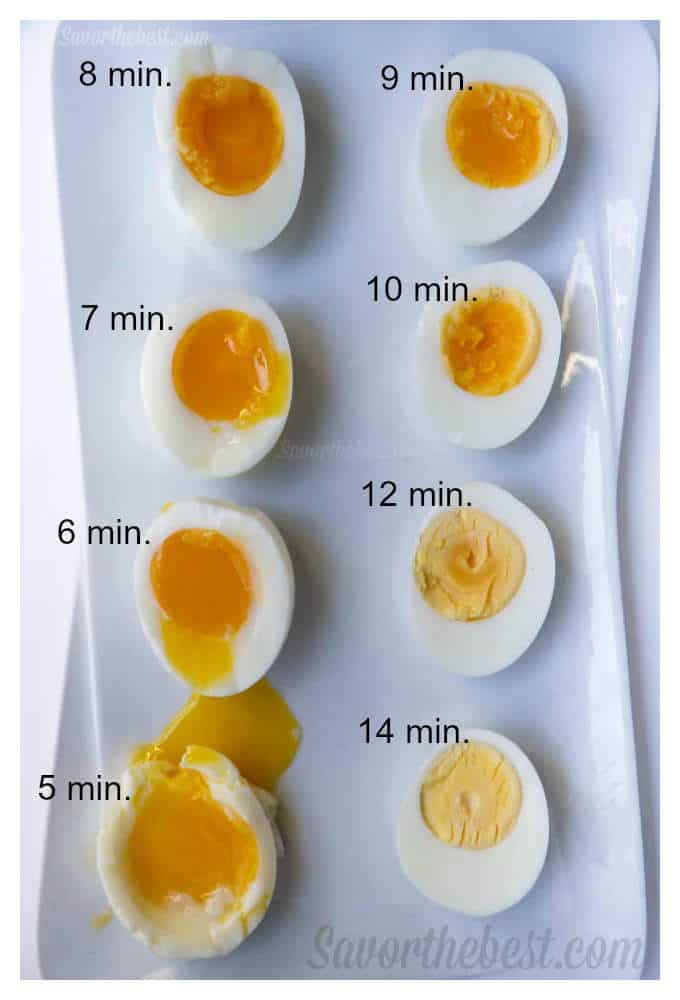
Can I overcook boiled eggs?
Yes, you can overcook a boiled egg. When eggs cook too long they become tough and rubbery. The most telling sign that a hard-boiled egg is overcooked is a green ring around the perimeter of the yolk. Check out the photo below to see what an overcooked hard boiled egg looks like.
You only need to boil an egg for 12 to 14 minutes. Beyond 14 minutes will make the egg tough and rubbery. The same thing happens with the other methods as well. Too much time in the pressure cooker or oven will result in a tough, rubbery egg.
It will still be ok to eat even if it has a green ring around the yolk, but it won’t be as good. Besides that, an overcooked egg starts to smell like sulfur. Yuk!
Cool the eggs down quickly when they finish cooking.
Even if you are diligent about taking the eggs out of the water at the right time, you can still overcook them. That’s because the residual heat will continue cooking the delicate eggs. The best way to make sure your eggs are perfectly cooked is to dunk them in ice water as soon as they are finished cooking.
Sometimes I run them under cold tap water but when I want to be precise and have that perfectly cooked 6-1/2 minute egg, I get out the ice.
How to peel hard-boiled eggs.
Hard-boiled eggs peel easier if you crack the shell all the way around the egg and let them sit in cold water for a minute or two. The water seems to seep in through the cracks and help the shell slide off.
I will either peel them in a bowl of water or hold them under running tap water while I peel them. Another method that works is to stick the eggs and some water in a well-sealed container. After the container is sealed, shake it vigorously until all the eggshells are cracked. If you’re a real good shaker, some of the eggshells will come off while you shake the container. The rest of them will slide off easily with your fingers.
No matter which method you use, the best way to make an easy peel hard-boiled egg is to start it off with immediate heat. For instance, when you boil the eggs, put them in hot water, don’t start them in cold water then bring the heat up. Getting them hot quickly makes all the difference.
Size does matter:
I used standard large eggs in all these methods. If you use jumbo sized eggs, the cook time will need to be increased a tad. And of course, if you use small eggs the cook time will need to be decreased.
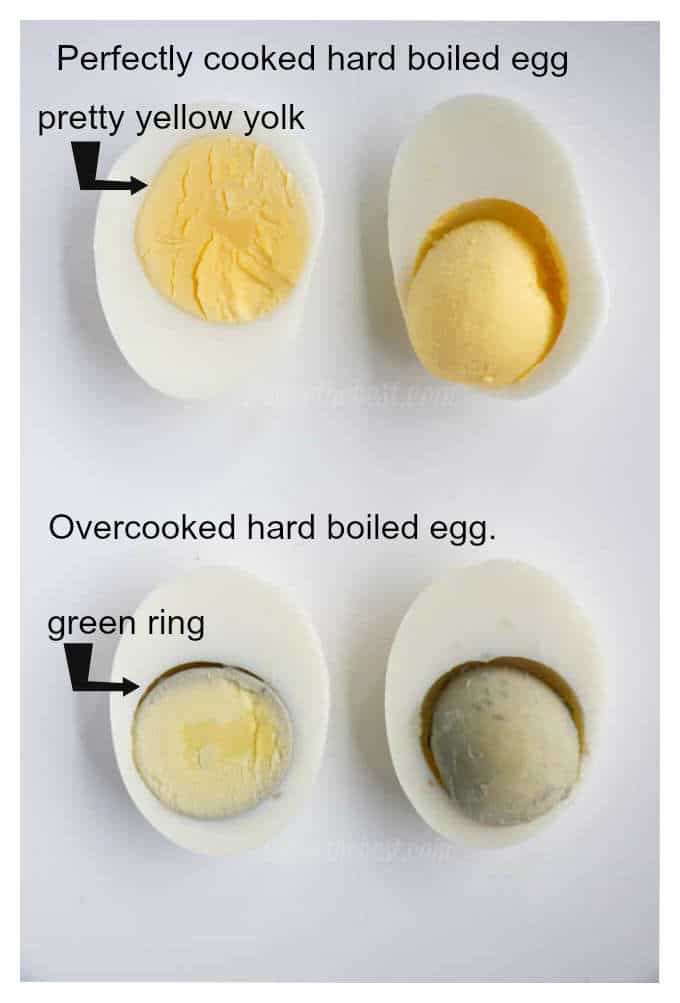
Make them ahead of time.
Hard-boiled eggs are perfect little make-ahead meals. Make them at the beginning of the week and store them in the fridge for a quick snack or easy breakfast. According to the Federal food safety site, hard-boiled eggs can be stored in the fridge for up to 1 week.
Hard-boiled eggs steamed
Steaming eggs is my favorite way to make hard-boiled eggs. Hard-boiled eggs in a steamer will be slightly more tender than the boiled water method.
The time it takes to cook a steamed hard-boiled egg is the same as a traditional boiled egg. However, the time it takes to boil an inch of water for the steamer is much quicker. You don’t have to wait for a whole pot of water to boil!
The steamed eggs are less likely to crack which makes them great candidates for your Easter egg hunt. Keep in mind that the times in the recipe card are for a single layer of eggs. If you stack the eggs on top of each other in the steamer, it will take longer for them to cook.
The picture below shows hard boiled eggs steamed for 6-1/2 minutes, 9 minutes, and 13 minutes.
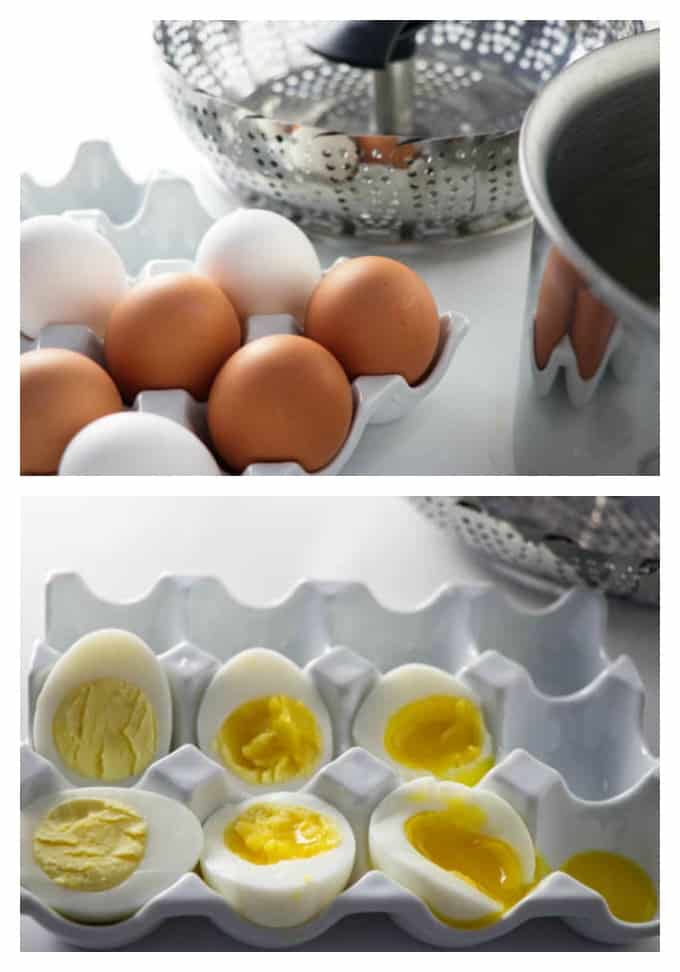
Pin this now to find it later!
Pin It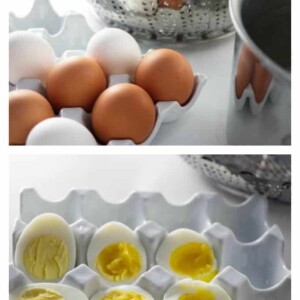
Hard-Boiled Eggs Steamed
If you make this recipe, please leave a star rating and comment.
Ingredients
- 6 large eggs, or as many as you want*
- Water
Instructions
- Add about 1 to 2 inches of water to a saucepan and bring it to a boil.
- Place the eggs in a steamer basket and when the water boils, place the basket in the saucepan.
- Place the lid on the saucepan and cook until the desired doneness, see below.
- When the time is finished, transfer to ice water to stop the cooking.
For Hard boiled Eggs
- Boil for 12 to 14 minutes
For Medium Boiled Eggs
- Boil for 8 to 9-½ minutes
For Soft Boiled Eggs
- Boil for 6 to 7-½ minutes.
Notes
- For accurate cooking times, do not stack the eggs on top of each other.
- You can use eggs straight from the fridge or eggs that have come to room temperature.
- Occasionally, steamed eggs will crack while cooking. You can help prevent the cracking by pocking a small hole in the shell.
- Keep the lid on the pot the entire time it is steaming.
- For precise cooking times from 5 minutes to 14 minutes, refer to the bulleted guide and photo in the post.
Nutrition
Nutrition information is automatically calculated, so should only be used as an approximation.
 Like this recipe? Rate & comment below!
Like this recipe? Rate & comment below!Hard-boiled eggs Instant Pot style
An Instant Pot steams the eggs under pressure. The eggs get hot quickly and cook super fast. This method seems to shrink the egg white away from the shell in the most efficient way. Out of all the methods, the Instant Pot made peeling eggs the easiest.
The downside to the Instant Pot is that it is harder to control precise temperature doneness. If you want a perfectly soft or medium boiled egg, the results are more variable but they are achievable.
Most of the information I found regarding boiled eggs in the Instant Pot recommended a 5-5-5 method. That stands for 5 minutes to come up to pressure, 5 minutes of cook time, and 5 minutes of natural release. No matter how many times I tried the 5-5-5 method, I felt the eggs were slightly overcooked. Many times I noticed a slight grey ring around the yolk which is a sure sign that the egg cooked too long.
The timing for a perfect hard-boiled egg in the Instant Pot
I found that 3 minutes is all that is needed for standard large eggs to become hard-boiled in the Instant Pot. That takes into consideration 5 minutes of natural release time which allows for additional cooking. So 3 minutes at high pressure and 5 minutes of natural release will give you a perfect hard boiled egg in the instant pot. Both the yolk and the whites will be tender and there won’t be a dreaded green ring.
A variable to keep in mind is the amount of water that this recipe calls for. I have seen some instructions that called for 1 cup of water. I only placed 3/4 cup of water in the Instant Pot specifically because that is the size of the container that came with the Instant Pot. It took less than 4 minutes for the Instant Pot to come up to temperature and begin cooking under pressure.
Every now and then, you will have an egg crack, perhaps because some egg shells are weaker and can’t withstand the ‘shock’ to the temperature change. You could put a small pinhole in the egg to help prevent cracking.
The photo below shows eggs cooked under high pressure at:
- 3-minutes with 5-minutes of natural pressure release
- 2-minutes with 2 minutes of natural pressure release
- 1-minute and immediate pressure release.
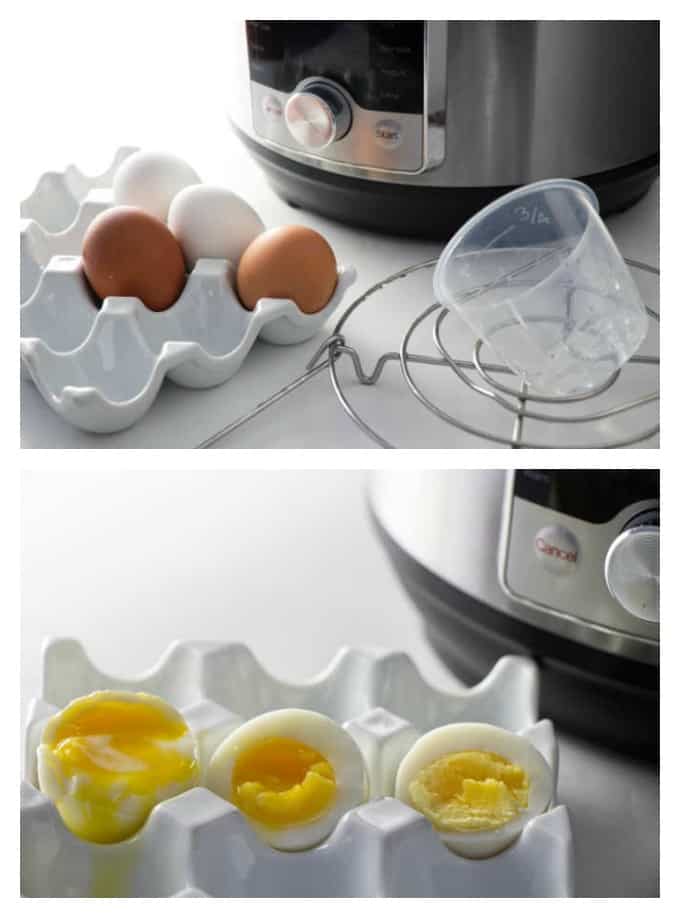
Pin this now to find it later!
Pin It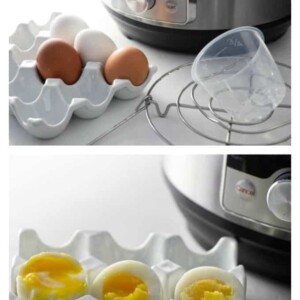
Hard-Boiled Eggs Instant Pot Style
If you make this recipe, please leave a star rating and comment.
Ingredients
- 6 large eggs, or as many as you want*
- Water
Instructions
- Add ¾ cup of water to the instant pot.
- Place the metal rack in the pot and place the eggs on it.
- Set the instant pot to high pressure for 3 minutes.
- When it is done cooking, let the instant pot sit and naturally release pressure for 5 minutes then release the rest of the pressure manually.
- Transfer the eggs to ice water to stop the cooking.
For Medium Eggs:
- Set the instant pot to 2 minutes at high pressure then let it sit and naturally release pressure for 2 minutes then manually release the rest of the pressure.
- Transfer the eggs to ice water.
For Soft Eggs:
- Set the instant pot to 1 minute at high pressure. Immediately release the pressure manually as soon as the 1 minute cook time is finished.
- Transfer the eggs to ice water.
Notes
Nutrition
Nutrition information is automatically calculated, so should only be used as an approximation.
 Like this recipe? Rate & comment below!
Like this recipe? Rate & comment below!Egg Cooker Hard Boiled Eggs
Yep, there really is such a thing as an egg cooker. An egg cooker actually steams the eggs just like the steaming method on your stovetop. The results are essentially the same as the stovetop steamer except there is less precision of the cook time. The egg cooker I used gave instructions for 3 pre-set levels of doneness.
All you do is pour in a pre-determined amount of water, stick the eggs in, put the lid on and press start. The egg cooker boils the water and steams the eggs. When the water is completely evaporated, an alarm sounds telling you that the eggs are finished. Easy! I used the Dash egg cooker.
The soft boiled egg in the egg cooker was close to a 5-1/2 minute egg. Remember what the 5 and 6-minute egg looks like in the photo above? That’s how the egg cooker made a soft boiled egg. The setting for a medium egg resulted in what was more like a soft cooked 7-minute egg (runny yolk and barely set whites).
Those results would be different if I had used small or medium eggs. I would expect a medium egg should give perfect results. Now, just because the Dash egg cooker only has 3 options for how long to cook the eggs doesn’t mean you are confined to those 3 options.
It would be easy to experiment with different amounts of water to get the results you want. The more water you add to the egg cooker, the longer the eggs will cook. Egg cooker hard boiled eggs are super easy. Someone else did all the thinking for you when they designed this little cooker. If you want easy-peel hard boiled eggs and minimal effort, the egg cooker delivers.
Cracked Eggs?
Even a gentle steamed egg will occasionally crack when it cooks. The egg cooker comes with a sharp pin so you can poke a small hole into the eggshell.
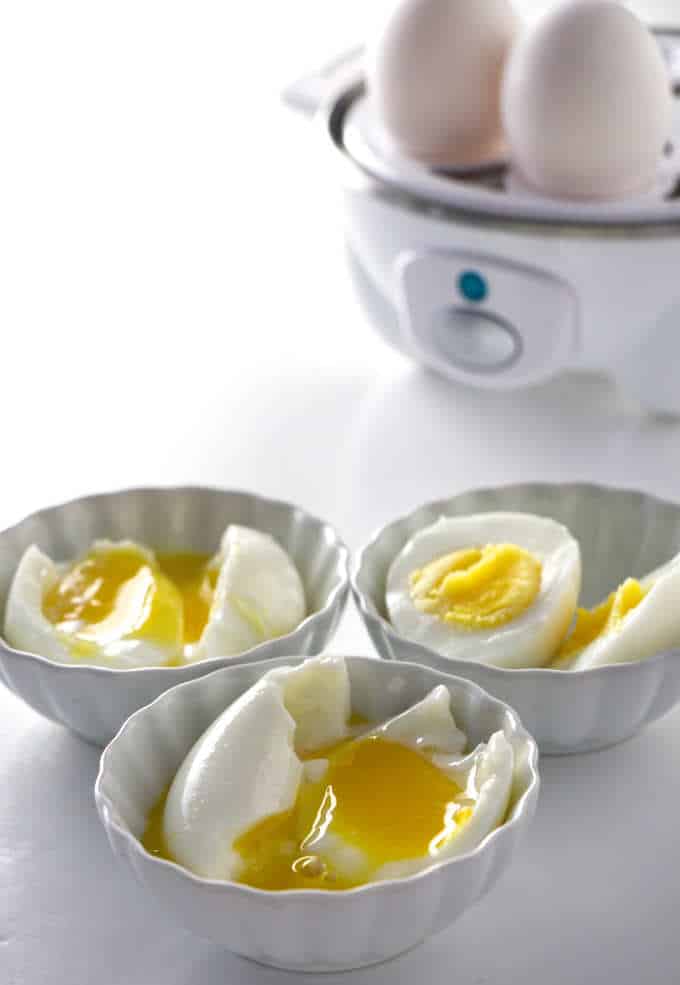
Pin this now to find it later!
Pin It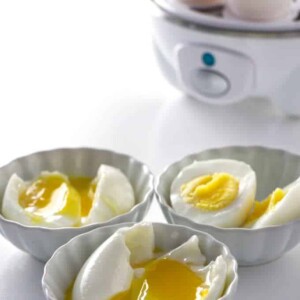
Egg Cooker Hard Boiled Eggs
If you make this recipe, please leave a star rating and comment.
Ingredients
- 6 large eggs, or fewer if you want*
- Water
Instructions
- Use the sharp pin that comes with the egg cooker to poke a small hole in the bottom of the eggs.
- Pour water into the graduated measuring cup. The lines on the Dash cooker have markings for soft, medium, and hard. Pour the water up to the desired line.
- Pour the measured water into the cooker.
- Place the eggs on the egg holder and set it on the cooker.
- Set the lid on (don’t tighten the lid) and press the start button.
- The egg cooker will beep when it is finished cooking.
- Transfer the eggs to ice water to stop cooking them.
Notes
- Pour a pre-determined amount of water in the cooker.
- Put the lid on.
- Press start.
Nutrition
Nutrition information is automatically calculated, so should only be used as an approximation.
 Like this recipe? Rate & comment below!
Like this recipe? Rate & comment below!Hard Boiled Eggs In the Oven
Have you ever heard of cooking hard-boiled eggs in the oven? It probably isn’t the most efficient way to make “boiled” eggs but it works. Place the eggs on a muffin tin or on a rack so they don’t roll around, then pop them in a HOT oven. Make sure the oven is up to temperature or the eggs won’t cook fast enough to make the shells easy to peel.
Oven baked “hard-boiled” eggs are fairly easy to peel. Out of all the methods, this is the least desirable in terms of an easy-peel eggshell. The biggest problem is that the part of the egg that sits directly on the muffin tin gets too hot and bakes the egg white onto the eggshell. That small portion of the egg is harder to peel and will leave a brown spot on the egg white.
The nicest hard boiled eggs in the oven baked for 22 to 24-minutes. Beyond 24-minutes made the egg whites tough and the yolks started to turn green.
Soft and medium eggs in the oven:
Soft boiled eggs took 16 to 17-minutes and medium eggs took 18 to 19-minutes. Like the Instant Pot, cooking soft and medium boiled eggs in the oven gave us more variable results. Sometimes 17-minutes looked like a 5-minute egg in the photo above and sometimes 17-minutes looked more like a 7-minute egg.
Frankly, I’m not really sure why you would want to make hard-boiled eggs in the oven when the other methods are so much more efficient and predictable. But maybe someday I will run out of water and I will be desperate for a hard-boiled egg. ??
Apparently, there are a lot of people searching for instructions for hard-boiled eggs in the oven. If you are one of those peeps, then rest assured that I went through a lot of eggs trying to find the best times for a perfectly baked hard-boiled egg. This is your definitive guide to hard-boiled eggs in the oven, outlined on the printable recipe card below.
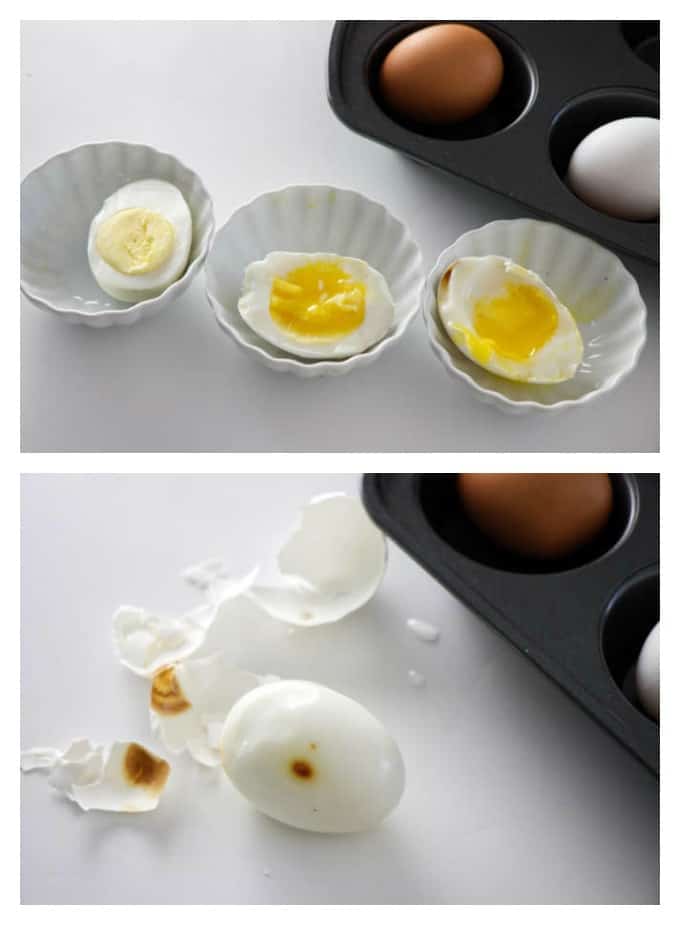
Pin this now to find it later!
Pin It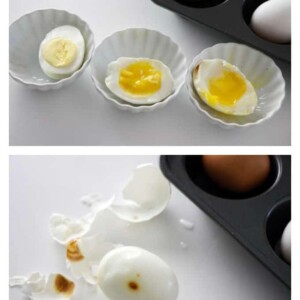
Hard-Boiled Eggs in the Oven
If you make this recipe, please leave a star rating and comment.
Ingredients
- 6 large eggs, or more if you want
Instructions
- Preheat the oven to 350°F.
- Place the eggs in a muffin tin or on a wire rack that is set on a baking sheet.
- Place the eggs in the HOT oven and bake for 22 to 24 minutes.
- Remove the eggs and place them in ice water to stop them from cooking too long.
- Allow them to sit in the ice water until they are completely cooled down.
- To peel the eggs, crack all around the shell then peel them under running water or in a bowl of cold water. The shell will slide off easier if it is wet.
For Medium Eggs
- Bake for 18 to 19 minutes
For Soft Eggs
- Bake for 16 to 17 minutes
Notes
Nutrition
Nutrition information is automatically calculated, so should only be used as an approximation.
 Like this recipe? Rate & comment below!
Like this recipe? Rate & comment below!Hard-Boiled Eggs Sous Vide Style
If you have a sous vide you know how much it can change the game of cooking. You also know that it is not something you do if you’re in a rush. Sous vide cooking is more like slow cooking with amazing precision. Making hard boiled eggs with a sous vide can be done a few ways but we are showing you how to make them so they are easy to peel.
Remember, the trick to easy peel hard-boiled eggs is to get them heated up quickly. That way the outer-most regions of the whites will pull away from the eggshell.
The most tender hard boiled egg you can get is one cooked at 180°F but that isn’t hot enough to make the eggs easy to peel. If you don’t care about an easy peel hard-boiled egg, then cook your sous vide egg at 180°F for 25-minutes. You will be amazed.
If, however you want eggshells that slide off the egg, crank the temperature up to 195°F. At that temperature, the eggs get hot fast enough to make them easy to peel but it is low enough to make a very tender hard-boiled egg. The sous vide will make hard-boiled eggs more tender than any other method.
What about soft and medium sous vide eggs?
A sous vide allows you to be super precise with the temperature. You can set the temperature for the EXACT level of ‘doneness’ that you want your egg yolk. A yolk that you cook to exactly 155 degrees is pretty amazing.
Since egg whites need higher temperatures to bond than yolks, the whites in soft sous vide eggs will be loose and runny. Th But the yolk will have an amazing, indescribable texture.
If you want amazing soft-set yolks, you need to try the sous vide boiled egg but be prepared for a runny white.
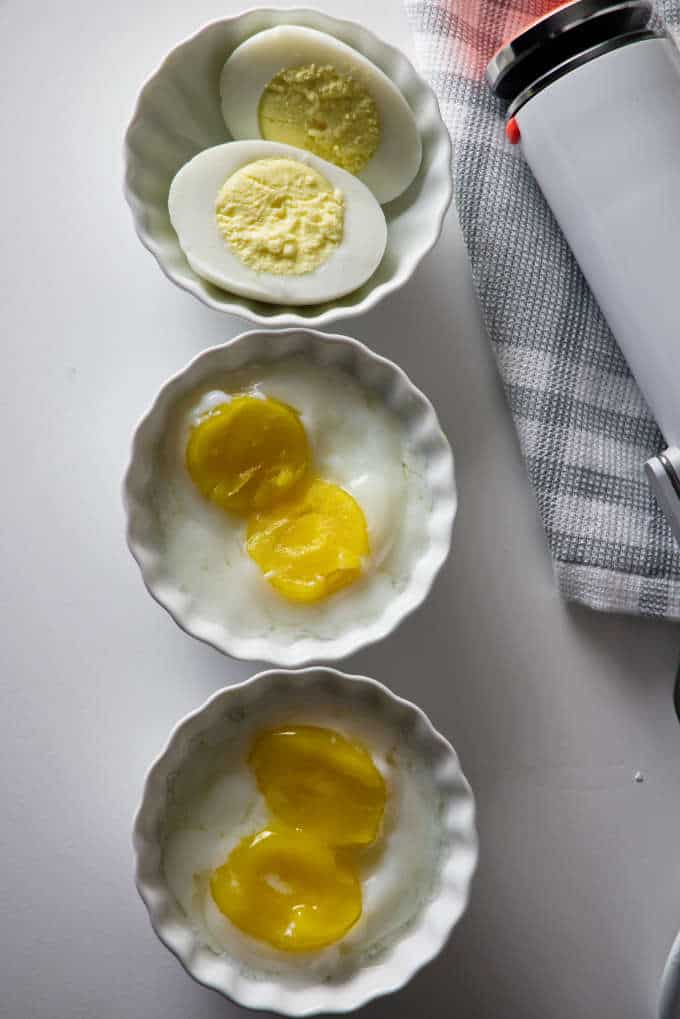
Pin this now to find it later!
Pin It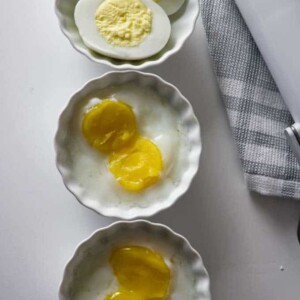
Hard-Boiled Eggs Sous Vide Style
If you make this recipe, please leave a star rating and comment.
Ingredients
- large eggs, as many as you want
Instructions
- Fill a pot with water and place the sous vide in the water. Set the sous vide to heat up to 195°F.
- When the water reaches 195°F, place the eggs in the hot water and set your timer for 14 minutes.
- After 14 minutes scoop the eggs out and place them in an ice water bath to stop the cooking.
- Allow them to sit in the ice water until they are completely cooled down.
- To peel the eggs crack all around the shell then peel them under running water or in a bowl of cold water. The shell will slide off easier if it is wet.
For Medium Eggs
- Set the temperature to 160°F.
- Place the eggs in the hot water and set the timer for 25 minutes.
- Remove the eggs to an ice bath to stop the cooking.
For Soft Eggs
- Set the sous vide temperature to 155°F.
- Place the eggs in the hot water and set your timer for 20 minutes.
- Remove the eggs to an ice bath to stop the cooking.
Notes
- The whites in the soft and medium cooked eggs will be very loose and runny but the yolks will be perfect.
- Make sure you wait until the water has completely heated up before you place your eggs in the water.
Nutrition
Nutrition information is automatically calculated, so should only be used as an approximation.
 Like this recipe? Rate & comment below!
Like this recipe? Rate & comment below!
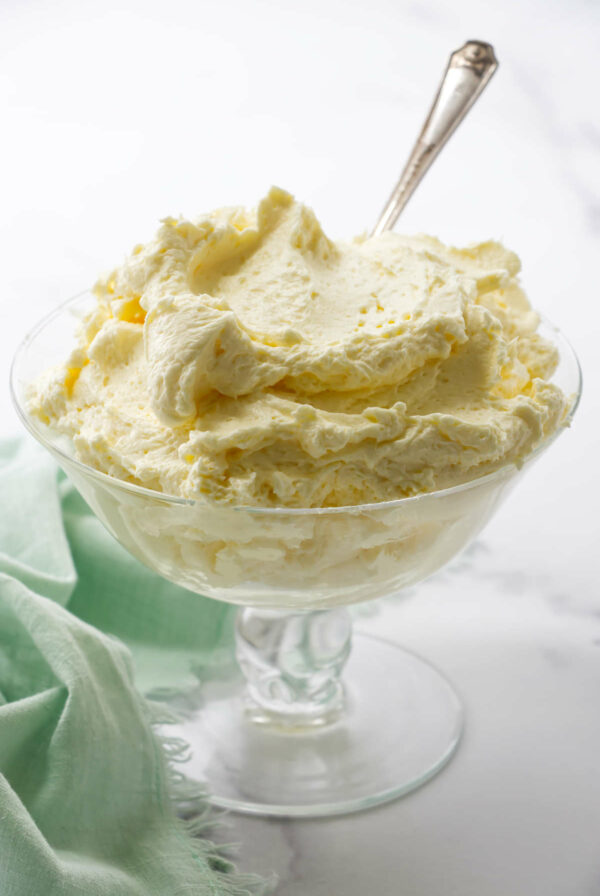
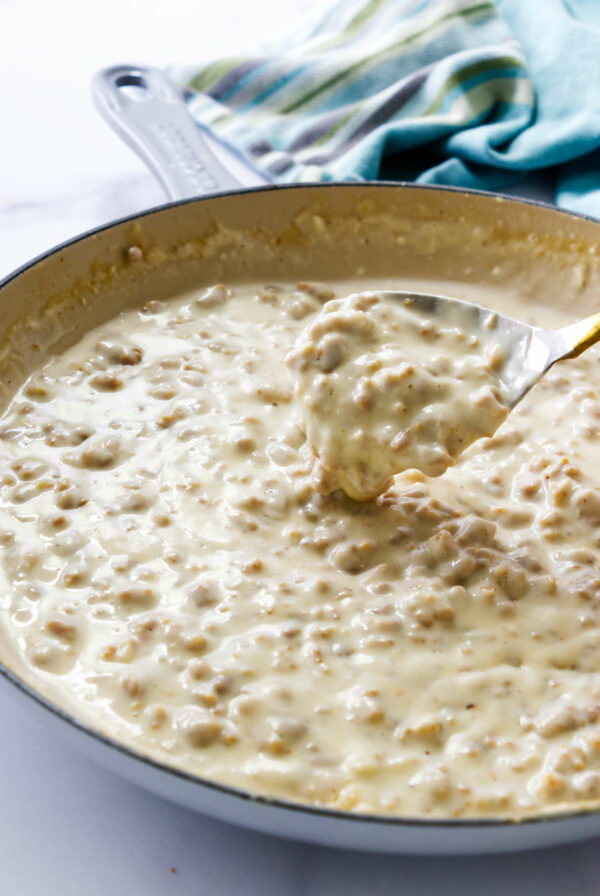
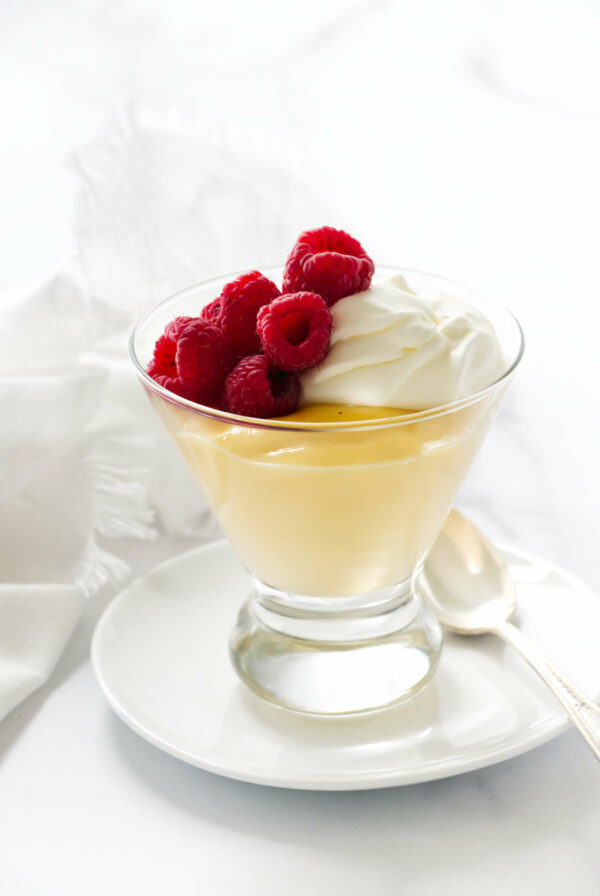
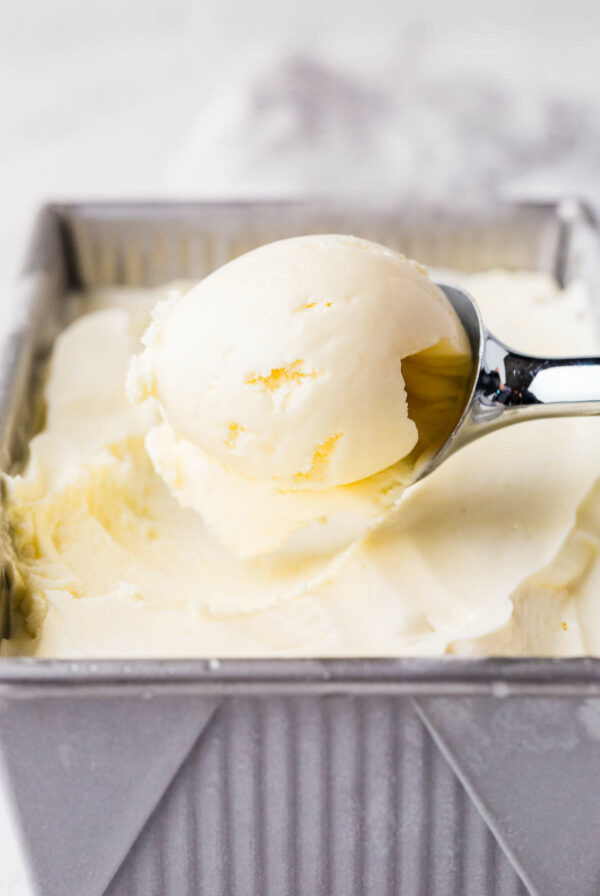










The ‘water under the shell’ trick is a game changer. Thank you!
Glad it helped Russell, thanks for the comment 🙂
I really like this comprehensive guide to hard boiled eggs! I can never get it perfect and have an easy peel but now I hope to!
Oh, this will make your egg pealing a success! Try the steamed method, I think you will be surprised at how fast and easy it is since you don’t have to wait for a large pot to boil. 🙂